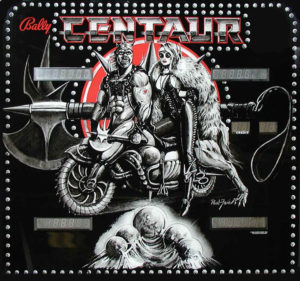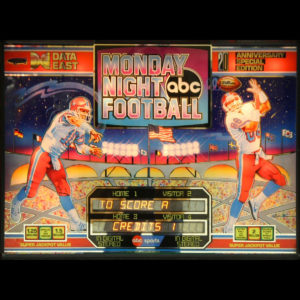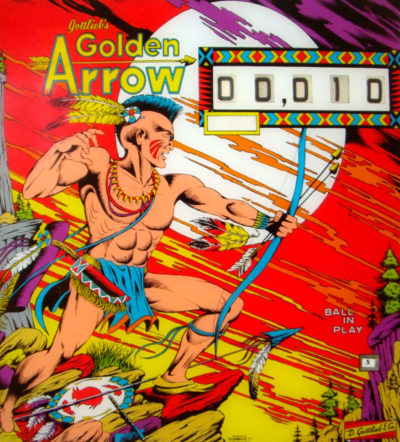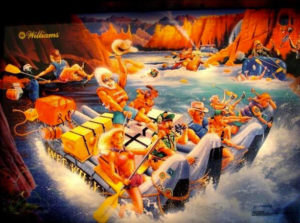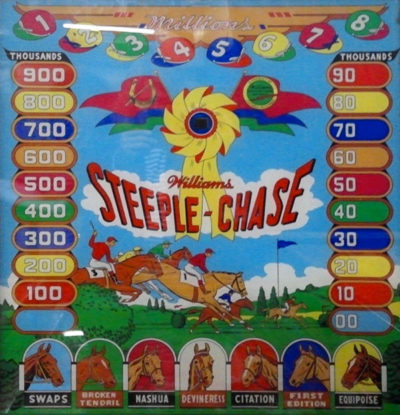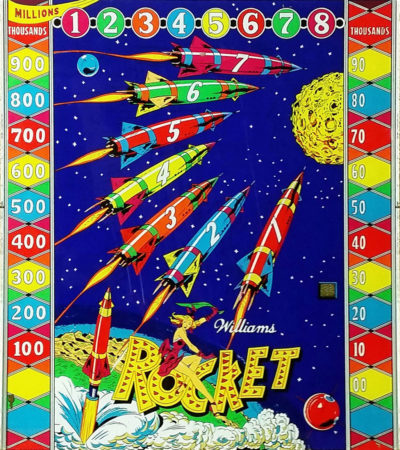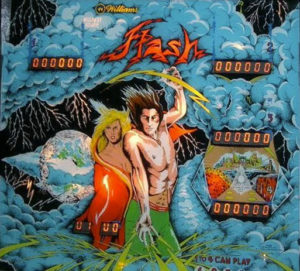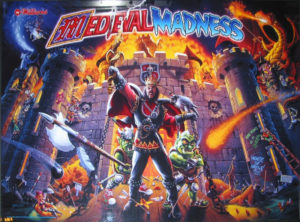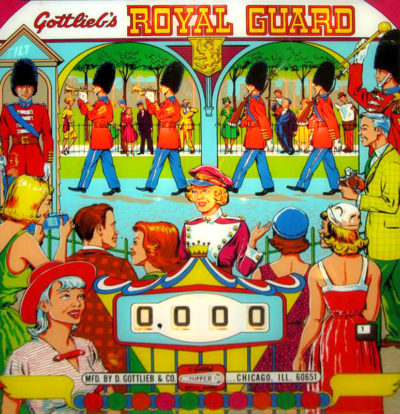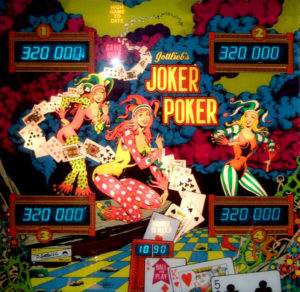-
Mata Hari was released in April of the year and designed by Jim Patla with artwork accolades going to Dave Christiansen. 16,200 of these machines were produced in the new solid-state format (as seen in the museum) as well as bunch of electromechanical machines (170, to be exact) to keep the non-computer savvy operators happy and buying machines they knew how to fix. This machine before you is one of the finest examples of this ultra-rare mechanical format. Like the solid-state version, the center kickout hole scores 3,000 points and each successful shot in the hole advances the bonus multiplier. The A and B skill shots advance the horizontal sequence of increasing values in the center of the playfield. 50,000 points are awarded when a battery of drop targets is hit. If both batteries are knocked down, the drop targets reset and hitting all again awards the replay. Score is another replay option.This beautiful piece of art was designed by Jim Patla with artwork by Paul Faris. 3,700 units were designed and a reprise run of 1,550 games were made in 1983 due to its popularity. The first thing one notices when walking up to this game is the color theme and the vibrant lighting. Pressing either flipper button when the game is in attract mode gives you an instructional light show on its features; the orb feature is the most exciting. Spelling out orbs by completing the drop target sequence stores another potential ball into play if the release orbs target is hit. This target has a magnet under it which holds the ball in position when the orbs are ejected. The balls are ejected from under the playfield through a baseball machine pitcher-like mechanism mounted upside down in the shooter lane. This mechanism was inspired by a Bally ‘50s game called Balls A Poppin. The captive ball drop target sequence is another tough goal to accomplish.This Gottlieb game is one of the five in the museum of the “flipper” series from Gottlieb. These games are all add-a-ball games. The layout of this game parallels a future Gottlieb classic by the name of “Buckaroo” (also in the museum). 1,550 of these machines were manufactured. Wayne Neyens designed the game and Roy Parker established the art package. Fifteen targets on the roto-target are present and spinning the roto would bring up new numbers to complete. If you are skillful enough to sequence four numbers in a row, an extra ball is awarded. The bull’s-eye target awards an extra ball also. Each time an extra ball is awarded, the backglass animation activates. The cowboy shoots at the targets, which causes them to spin. No match feature here and tilting the game forfeits the ball in play as well as a future ball in play.Here’s another example of a Gottlieb single-player mechanical game when all the other manufacturers during this period were developing solid-state computerized machines. Ed Krynski is the designer with Gordon Morison the artist of choice for this model, one of 1,530 machines made. The machine itself is a classic ’70s. Ten numbers is your goal here. You achieve these ten targets by hitting and rolling over the appropriate spots on the playfield. Hitting the spinner spots the numbered target the spinner stops on. If you’re lucky to complete the targets, the special lights up and advances through the ten numbers. Hitting the lighted number with “special” lit means more free time playing the game. Score for replays is your second goal. Nice artwork in a single player game, one of the last produced.White Water is a 1993 pinball game designed by Dennis Nordman and released by Williams. The theme is based on White water rafting, which is reflected in the game’s ‘wild’ ramps and very fast gameplay. Overview White Water is a non-licensed pinball machine with a primary objective of moving your raft down the river to “Wet Willy’s” in order to get the “Vacation Jackpot.” You move your raft down the river by shooting the flashing “Hazard” shots, each with a unique rafting theme name. Each time you complete a raft, the number of “Hazard” shots you must hit successfully to complete the next raft increases. It takes eight completed rafts to advance to “Wet Willy’s.” Successfully completing “Wet Willy’s” enables the player to attempt the collection of the “Vacation Jackpot.” There are subsequent objectives in the game, which include: Multiball: To start multiball, light the lock ball shot by hitting the “Lite” and “Lock” targets and then successfully shooting the ball in the ball lock, also called the “No Way Out” Hazard; doing this 3 times will start multiball. Whirlpool: Completing the “Whirlpool” shot will activate one of six awards or modes, which is determined by what is lit when the “Whirlpool” shot is hit. To light the “Whirlpool”, thus making the shot active, successfully hit the “Insanity Falls” shot. After hitting the “Insanity Falls” shot, you will know the “Whirlpool” is active when the red light above the shot is lit. One of the six awards or modes starts when the Whirlpool shot, also called “Bigfoot Bluff”, is successfully competed. Big Foot Hotfoot: There are two “Hotfoot” targets in the middle of the playfield. Hitting both targets comprises a complete “Hotfoot”, and the “Hotfoot” targets are reset. Depending on the machine settings, successfully completing the specified number of “Hotfoot” targets starts the “Bigfoot Hotfoot” mode which allows the player to get successive “Bigfoot Jackpots.” Lost Mine: Hitting the ball in the “Lost Mine” shot awards an item needed to start the “Gold Rush” multiball. There are three items that must be collected to start this multiball, a flashlight, a map, and a key; and these items can be collected through either the “Lost Mine” or the “Bigfoot Hotfoot.” Once all three items have been collected, successfully hitting the “Lost Mine” shot starts the “Gold Rush” multiball.This unique woodrail game was screwed together in November of the year following the success of a Gottlieb space theme called Rocketship. Harry Williams designed the playfield and game rules while George Molentin inked the artwork. The object of the game is to score at least three rockets on the backglass in order. Doing so awards a replay. This is not an easy task as most of the rockets are “selected” at the top of the machine’s playfield and, even though you may have had a countdown going on a desired numbered rocket to complete this feat, the next ball will most likely change the selected rocket in your countdown sequence! To spot a rocket, you must count down five levels to light the fire bumpers. Hitting one of these spots your actively selected rocket. More replays are yours if you can achieve four, five, six, or seven rockets in order, an extremely rare feat. Score is also another way to score replays. A very challenging playfield for sure, between trying to change your selected rocket and the high-side drain exits take some time to master.This game was a breakthru game for Williams in January. It was designed by Steve Ritchie with art by Constantino Mitchell. Flash was the first game to have a continous background sound during play and the crescendo of the sound sped up as you advanced thru the game. This is also the first game to use “flash lamps”, which are higher voltage lights that really make a presence when they light. The first thing you notice on this non-speaking game is, when you shoot the ball from the plunger, the ball travels diagonally across the playfield and ends at the top of the playfield from left to right. The top rollovers consist of 4 numbers. If you hit 1-3, you get a double bonus; all four made gives a triple bonus. 19,505 games were made, a big production run. This game also has the advance bonus eject hole, drop targets, and, of course, the bright “flash” show when activated. This game was a main staple in arcades of the ’80s.Flippers (2), Pop bumpers (3), Ramps (2), Autoplunger. A left-side catapult propels ball airborne into a habitrail. Two pop-up trolls in playfield become active during “Trolls!” mode. Tina Fey (of “Saturday Night Live” fame) did the voices of the “Opera Singer” princess and the Cockney-talking princess, and Andrea Farrell did the voices of the Jewish princess and the sexy princess. Greg Freres was the voice of the jousting announcer and one of the trolls while Francois Du Grim was voiced by Vince Pontarelli who also did the other troll. Look no further! This game, in my humble opinion, takes the prize as the most sought-after, inventive game of the ‘90s! Brian Eddy designed this machine with 4,016 units screwed together. The action, endless vocal calls, the exploding castle, the pop-up trolls and the moat and dropping gate make this machine one of a kind. The value of this machine is going through the roof, more than doubling its original price. The six kings from six different castles must be defeated by attacking the castle walls. Defeating a king makes the fort collapse. It’s nearly impossible to complete this feat. The princess must be rescued up the upper right ramp when activated (the princess’s vocals are none other than Tina Fey’s voice). Many multiball challenges await. The trolls must be hit many times to be conquered. The whole package is artistically and musically amazing. Most of these machines are tucked away in home arcades at this point. Enjoy!Gottlieb Joker Poker pinball. An interesting design, and only made in a 4 player version (no 2 player, unusual for Gottlieb pinball). One bank of five ace drop targets, one bank of four king drop targets, one bank of three jack targets, one bank of two queen drop targets, and a single ten drop target. Pretty cool pinball design really. Two pop bumpers, one slingshot, two 3″ flippers. They made 820 Gottlieb EM Joker Poker pinballs.
-
Mata Hari was released in April of the year and designed by Jim Patla with artwork accolades going to Dave Christiansen. 16,200 of these machines were produced in the new solid-state format (as seen in the museum) as well as bunch of electromechanical machines (170, to be exact) to keep the non-computer savvy operators happy and buying machines they knew how to fix. This machine before you is one of the finest examples of this ultra-rare mechanical format. Like the solid-state version, the center kickout hole scores 3,000 points and each successful shot in the hole advances the bonus multiplier. The A and B skill shots advance the horizontal sequence of increasing values in the center of the playfield. 50,000 points are awarded when a battery of drop targets is hit. If both batteries are knocked down, the drop targets reset and hitting all again awards the replay. Score is another replay option.




